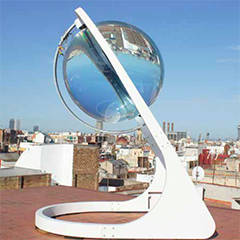The use of a clear “ball lens” to concentrate light into a beam of energy may improve solar power efficiency by up to 50 percent, believes a PV pioneer. Plus, we take a look at some other solar innovations that may transform our industry.
Over six years ago, futurist Ray Kurzweil stated that, within 20 years, solar power technology would move forward to the point where it would be able to supply all of the world’s energy needs. His forecast wasn’t too optimistic considering that the amount of energy Earth receives in just one hour would be enough to power humans’ lives for an entire year. But now, even the most ardent supporters are no longer willing to help subsidize this once bright vision of the future.
German architect André Broessel, who has clearly thought long and hard about the insufficiencies of solar, claims that he’s invented a model device that’s designed to get around the technology’s existing bottlenecks. Fundamentally, his Betaray concept isn’t a radical departure from other panel technologies out there since it also uses solar cells to collect sunlight. And tellingly, explains: “We can squeeze more juice out of the sun.”
Broessel’s vision
We all know that the sun is the greatest sustainable energy source on earth. Since more than over 40 years the technology helps us to transform this source into power. The problem is the low efficiency: 80% of installed PV panels worldwide have a performance of 15% or lower; but if the panels are not tracked with the sun, the average of annual tilt losses add up to minus 70%.
We’ve been through a long research and creative process, from early studies, concepts and sketches to 3D models, calculations and prototypes, loads of Ball lens studies, through to measuring the performance and the energy transmission values. Through these tests we reached the conclusion that the perfect shape of the ball lens not only has excellent energy transmission, but also the capability to concentrate diffuse light.



























